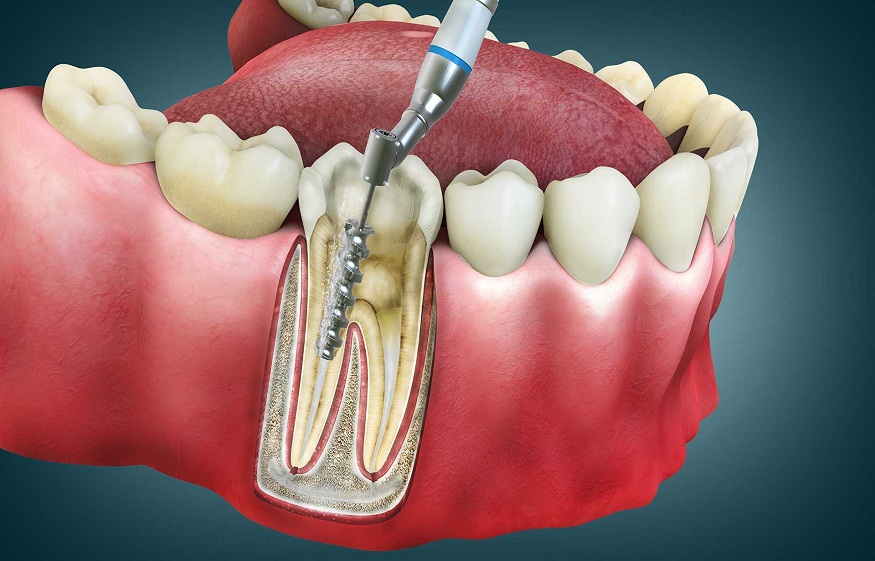Root canal treatment is one of the most common reasons for consultation for dental emergencies. If you have a damaged or infected tooth, it no longer has its vitality and dies. This results in damage to the pulp chamber which can lead to pulp mortification. If, previously, dentists were obliged to extract the tooth, they can now carry out root canal treatment to save the tooth suffering from this pulp mortification. But what does it consist of and who is such treatment intended for?
Root canal treatment takes place over several sessions
A dam to protect the tooth
Several sessions with the dentist or endodontist (specialist who treats the inside of the tooth) are required to carry out the root canal treatment. The process begins by protecting the tooth against bacteria present in saliva by installing a thin rubber dam around the tooth.
Requiring the use of local anesthesia, this step continues with the making of an incision at the level of the tooth, which provides access to the pulp chamber and the root system. In this way, the dentist can remove dead or infected tissue, clean the canal, widen it and shape it to facilitate filling.
Typically, these actions are performed with motorized instruments, but the dentist or endodontist may also use manual endodontic files to scrape the interior surface of the pulp canals. Irrigation is also carried out using a chemical disinfectant.
If these tissues are not extracted, there is a risk of infection of the cells surrounding the root of the tooth, resulting in greater inflammation and pain. In addition, the dentist or endodontist can, at this time, promote the elimination of bacteria through the introduction of certain medications into the pulp chamber and the root canal.
A temporary filling of the canal
So that saliva does not enter the pulp chamber and the root canals, the canal obtained by opening the crown is completely closed with a natural inert material. This is a temporary filling. Additionally, if the infection extends beyond the root tip, the dentist or endodontist may prescribe antibiotics to the patient.
During the following session, the temporary material is extracted so that the root canal can be permanently filled and sealed. For this purpose, the dentist or endodontist uses a natural biocompatible material, most often heated gutta-percha.
Restoring tooth structure, function and appearance
In the event that there is not enough natural tooth remaining, it is possible to use a metal or plastic post at the root canal as a support, before placing a crown on the tooth.
The stage of restoring the structure, function and appearance of the tooth is accomplished through the installation of a porcelain or metal alloy crown on the tooth. Indeed, following root canal treatment, the tooth is weakened and is more likely to break. The use of the crown or dental pivot allows it to be more solid.
It should be noted that making the crown is the responsibility of the dentist. So, if it is your endodontist who took care of your root canal treatment, he will recommend you to your dentist for the preparation of it.
It is to be expected that the price of a root canal treatment will be quite high, considering the workload and the steps required to carry out the process. However, this constitutes a much more comfortable and viable investment than extracting the affected tooth. It will allow the patient to have healthy and usable teeth for a long time, which increases their quality of life.
In what situations is root canal treatment used?
The dentist and endodontist use root canal treatment mainly when there is an infection in the pulp. As a reminder, the pulp is the soft tissue that fills the pulp cavity, in the center of the tooth. The innermost part of the tooth, the pulp is made up of nerves and blood vessels, giving it sensitivity and vitality.
This infection in the pulp cavity can be due to a crack or traumatic injury to the tooth as well as deep decay. It also has harmful consequences on the root canal which is located under the pulp and can cause abscesses which affect the end of the root, causing pain and inflammation.
Thanks to root canal treatment, which consists of cleaning and disinfecting the inside of the tooth, it is generally possible to heal it and prevent it from losing its vitality so that the patient can keep it for many years to come.
While the material used for the permanent filling generally lasts a lifetime, replacement of the amalgam or crown should still be considered in the long term.
Misconceptions about root canal treatment
When talking about root canal treatment , many can’t help but shiver in advance, fearing that it will be a painful procedure, thinking of the small opening made in the tooth to reach the pulp chamber and the root system, the scraping, the filling and everything else.
But as we have already noted above, making the incision is preceded by local anesthesia. The same applies to all stages of root canal treatment which are likely to cause pain for the patient.
Thus, contrary to popular belief, it is not a treatment that hurts but which, in concrete terms, helps relieve the pain generated by dental inflammation or infection. However, it is not a miracle treatment that will make the pain disappear immediately. Rather, it will lead the patient towards healing gradually.
Although the patient will generally notice a significant improvement in their situation after root canal treatment, the tooth may still be sensitive the first few days following it, especially when chewing.
However, the pain should have completely disappeared in the following weeks and not persist for months, which may be a sign of improper root cleaning or a fracture of the tooth. If you experience persistent pain, do not hesitate to consult a dentist or endodontist.










